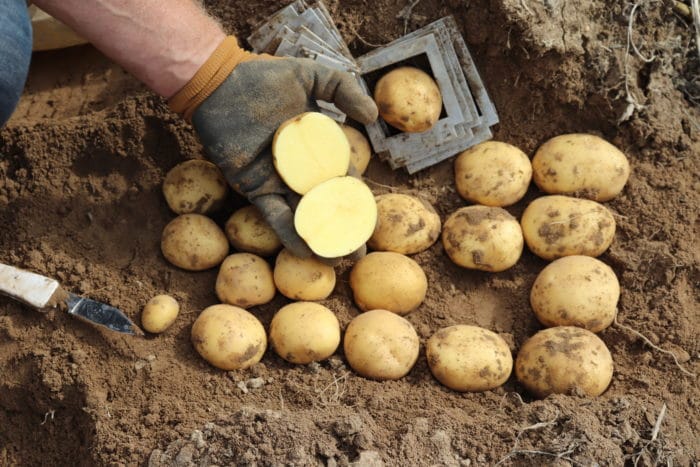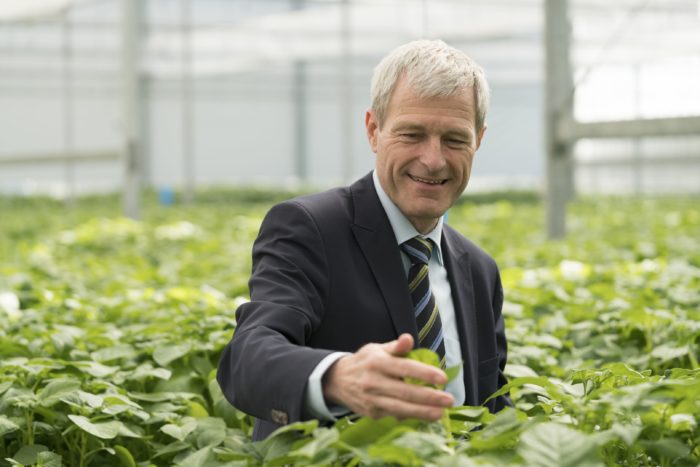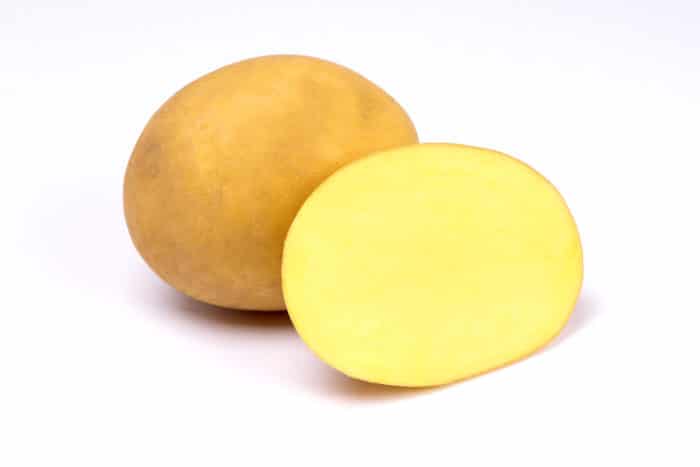The push continues for potatoes that can be grown with less water, other inputs, with Earth Fresh Farms trialling a new variety.
It’s not a secret that potatoes are both water hungry and grown in plenty across North America. However, with recent periods of prolonged drought and dryness in both Canada and the United States, water availability is becoming an increasingly larger issue. Luckily, potato breeders have been working on low input potatoes, which includes water consumption, to grow more sustainable potatoes in a world with a changing climate and weather patterns. The conversation has changed and it’s clear there’s a strong focus now on varieties that will not only reproduce well for various processing industries, but one that also aligns with many countries’ efforts to reduce carbon footprints while maintaining yield. The answer is as simple as it is complex, and genetics plays a large role.
One company, Burlington, Ont.-based Earth Fresh Farms (EFF), is inching closer to bringing new, low-water-use varieties to market in North America. After partnering with Hamburg, Germany’s EuroPlant, it began trialing lower water use potatoes around North America in 2017. The genetics were then first propagated at EFF’s Potato Seed Solutions breeding centre in Idaho Falls, ID. About halfway through its bring-to-market phase, there’s continued hope there are rock solid varieties for growers that would be available by spring 2026. This year, trials are beginning in Manitoba for the first time with company president Tom Hughes optimistic that the current variety dubbed Danina, a yellow fleshed, yellow skinned potato, can be one of many that continue to provide yield while cutting back on water demands.

“This past year has really highlighted how tough it is for potato growers when the weather turns sour for them,” says Hughes in a phone interview. “Our breeders have been working to develop varieties that are more drought tolerant and these varieties, you can’t grow them without any water, but you can grow them with less water.”
How much less? About 23 per cent, according to Earth Fresh’s 2021 trial data, which included research plots in Idaho, Wisconsin and Arizona, considering water availability in certain U.S. states as well as certain parts of Western Canada fighting drought. Hughes acknowledges each growing area is different, but estimates a new variety such as Danina could save farmers US$11.50 per acre on water costs.

For Hughes, a large upside to such a variety is that reduction in water as an input will be critical moving forward, especially as climate change continues to affect growing conditions for North American potato farmers.
“It would be nice to have varieties that still perform well for the growers, that’s the main thing, (that) even in tougher years, they’ll still be able to get a good crop,” he explains.
Sustainability Push
It’s not just EFF that’s keen to capitalize on lower input potatoes with a bigger sustainability ethos behind it. HZPC is the single largest exporter of potato genetics globally and has been working feverishly on varieties that require less water, as well as other inputs. According to company president Gerard Backx, the United Nations’ Sustainable Development Goals, namely no poverty and no hunger, nicely dovetail into his company’s mission and vision for the future, and he believes potatoes are the most logical way to achieve that.

“The higher the output with lower input, that’s important,” he says. “We work hard to increase the output and create high-yielding varieties with good resistances.”
Backx understands though, that business decisions often drive the varieties grown. He cites the unending popularity and familiarity of the Russet Burbank in North America for french fry production because of its predictability and observes that processors have created their production lines to work well with that specific spud. This in spite of the fact that higher-yielding, lower input potatoes are already available to growers.
“We have created several newer varieties that are giving higher yields in the last 10 years,” he says, adding they outperform russets in with ease. “At the end, you have to look at what the consumer wants.”
Other countries are most receptive to different varieties of potatoes and Backx uses the example of India, where HZPC has its potatoes grown regularly in a wheat-rice-potato rotation. The potatoes are grown in 85 days and yield 20 per cent higher than previously grown varieties.
While other crops have benefited from being relatively more popular, Backx says, adding that a potato has “very complicated genetics” with low margins. However, the company has been at it for 15 years focused on which varieties could perform better in drought or dry conditions and it’s paying off today for growers around the world.
Backx, a plant breeder by trade, continues to be optimistic about the future of potato’s potential. Theories touted about maximums a given plant can produce when he was a university student have all been broken.
“I don’t see a limitation on potato breeding,” he says. “Physically it can yield 100 pounds per acre, but I would not see any limitation for 100 to 120. Genetically, we should be able to work towards that. There’s still a long way to go, but I see in younger material we have, we are coming with varieties with much higher yield. We can continue to build on that.”
A Tricky Trait

It’s easy enough to set the goal to develop low water use potatoes, but it certainly takes meticulous work in laboratory settings and the field and during the first few years of variety trials, explains Helen Tai, federal potato geneticist in Fredericton, N.B. Of the 60,000 or so annual progeny in the breeding program, only one, maybe two tubers, are selected to go forward.
“It’s a complicated trait and it would require a lot of replication to ensure it’s happening,” she says, adding potatoes are water hungry plants.
Tai notes that even if a better variety is selected by breeders, there must be adoption by processors that includes adjustments to the existing production system on the farm, in the storage and on the fry processing line. In North America, she says 30 per cent of all potatoes are Russet Burbank, destined to become french fries.
“Russet Burbank dominates the production in the U.S. and Canada,” she says. “When we talk about improving varieties for Canada, it’s limited to some extent because of the end usage. Right now, something has to displace Russet Burbank. Many growers would say, ‘I don’t like growing Russet Burbanks, but that’s my contract.’”
Tai says variety utilization is driven by industry, and sector-wide collaboration will be needed to drive change to lower water use varieties.
“There’s lots of interest in processors and growers,” she says. “Industry has to have a lot of support to make this transition.”

Part of that transition will be including shifting climate and weather patterns as a key consideration for variety adoption, not just yield potential of a given potato variety.
“As we face these climate challenges, one of them will be can we maintain our resources for irrigation? That really drives the interest in getting crops that don’t require lots of water,” she says. “A lot of growers need to pay for water rights. These sorts of things will be driving more interest in reduced water use.”
Additionally, potatoes are eager for nitrogen, another input with sky-high costs, and farmers will also want to know about varieties that carry a lower N requirement, as well. Beyond that, though, is shifting the preferences of the potato industry as a whole, though.
“The adoption question is one that’s really important,” she says. “You can develop varieties, but to get them adopted and utilized is really the next step.”
Header photo — The Danina potato, being brought to market in North America by Earth Fresh Farms. Photo: Earth Fresh Farms
Related Articles
HZPC’s Future Proofed Potato Varieties
The Regenerative Ag Debate for Growing Potatoes, is it Possible?








